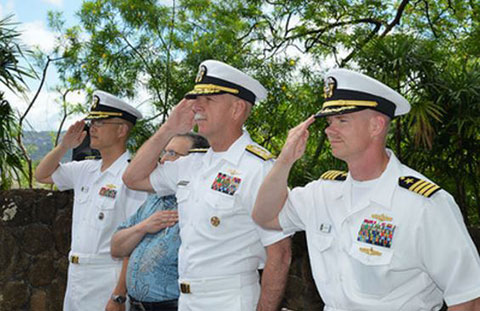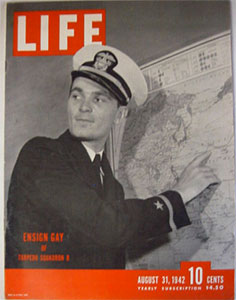Battle of Midway 07 JUN Formal Ceremony at PACFLT HQ
Battle of Midway 07 JUN Formal Ceremony at PACFLT HQ

When: 07 June 2016,1000-1100
Where: Pacific Fleet Headquarters, Building 250 Flagpole, Makalapa Crater
Dress: Military- Summer Whites (Navy) Other: Duty uniform. Civilian: Aloha smart casual
Questions to LTJG Manpreet Hotelling 474-4442 manpreet.hotelling@navy.mil
They say that time heals all wounds. Ancient enemies can become friends, as is true about the nations of Japan and the United States. Other Asian nations become insistent and assertive in their perceived national needs, driving old foes closer together. But there are other old animosities from the Battle of Midway that still simmer.
This is not the time to revisit the bitter feelings that went along with the greatest feat of code-breaking and all-source analysis in the Pacific War. Most of the truth has come out about all that, and it is appropriate to concentrate on both the contributions of Naval Intelligence to the victory, but also to celebrate the sacrifice of those who fought the battle, and those who did not survive to see the triumph of arms to which they contributed everything.
I had an opportunity to meet ENS (actually LCDR) George Gay many years ago at the EAA Fly-In at Oshkosk, Wisconsin. He was an older gentleman then, still alert, and selling copies of the book he wrote about the epic battle from a ringside seat. Gay was the first of his squadron- Torpedo 8- to take off from Hornet on June 4, 1942. Gay's unit found the Japanese carrier strike force and launched an immediate attack without fighter or dive-bomber support.
Although wounded from intense anti-aircraft fire, and with his radioman dying in the rear cockpit, George completed his torpedo run on the aircraft carrier IJN Kaga. The Japanese flat-top conducted an evasive maneuver and dodged the problematic MK-13 torpedo George had delivered.
Rather than banking away from the ship and presenting a larger target to its anti-aircraft gunners, Gay continued in toward the carrier at low altitude. He then brought his Devastator into a tight turn as he approached the carrier's island, and flew aft along the flight deck's length, thus evading defensive AAA.
In his book (which he graciously signed for me) he mentioned that he briefly considered crashing his airplane into the pack of Japanese aircraft being serviced and re-armed on Kaga’s flight deck, presaging a tactic later adopted by an increasingly desperate Japan late in the war.
He didn’t do it, and did not know how badly his radioman was wounded. He decided to make for Hornet after clearing the Japanese carrier. In the event, though, the slow-moving Devastator was bagged by a gaggle of five A6M Zero fighters, who peppered the aircraft with a hail of machine gun and cannon fire.

George pancaked his aircraft into the water, and exited the cockpit after seeing that his crewman was dead. Swimming away from the sinking wreckage, he hid under a seat cushion to avoid strafing attack by the Japanese.
Three other aviators were plucked from the water by the Japanese. They were interrogated and then executed.
George witnessed the subsequent devastating attacks by Yorktown and Enterprise SBD Dauntless dive-bombers that sealed the fate of three Japanese carriers.
It is those gallant men from Torpedo 8 and their comrades who carried out the desperate attack that this ceremony honors- and the pilots of the F4F Wildcats who tried to protect them, and the courage of the Dauntless crews who popped their speed-breaks and pointed their noses straight down to deliver their bombs with such decisive effect.
And to all the sailors who served in the gray hulls, and the Marines and SeaBees in defensive positions on the coral atolls of Midway who awaited the landing parties of Japan. American losses at Midway included 147 aircraft and more than three hundred sailors.
It was an honor to have met ENS Gay, who passed from this life in 1994. He was a genuine American hero.
Oh, I should mention that there is a Naval Intelligence postscript to George’s story. The official version is that when darkness came, he felt invisible enough to inflate his life raft. After thirty hours in the water, he was rescued by a USN PBY Catalina, the only surviving member of the thirty aircrew from Torpedo 8 who went flying that day.
Later, they took George to visit Admiral Nimitz to confirm the destruction of Kaga, Akagi and Soryu. He was featured in the August 31, 1942 issue of Life Magazine.

I mentioned my brief encounter with George Gay to our pal RADM Mac Showers at the Amen Corner of the Willow Bar a few years ago when we were discussing what it was like to be at Station HYPO during the battle, 70-odd years before. Mac gave me that tight grin of his, and his eyes crinkled in merriment.
“That bit about George seeing the three carriers go down? That was us, not him. George couldn’t see anything from where he was in the water. Kaga, maybe, but not the others. We wanted to get the good news out to the American public about what had happened, and we needed a cover. We obviously couldn't say it was from penetrating the JN-25 Naval Codes. We used George, and we gave him the ring-side seat.”
“I’ll be darned. I wish I had been able to ask George about the real story.” Then I took a sip of the Willow's Happy Hour white, and smiled along with Mac. Great Americans, they were, all of them.
Copyright 2016 Vic Socotra
www.vicsocotra.com
www.navintpro.com
